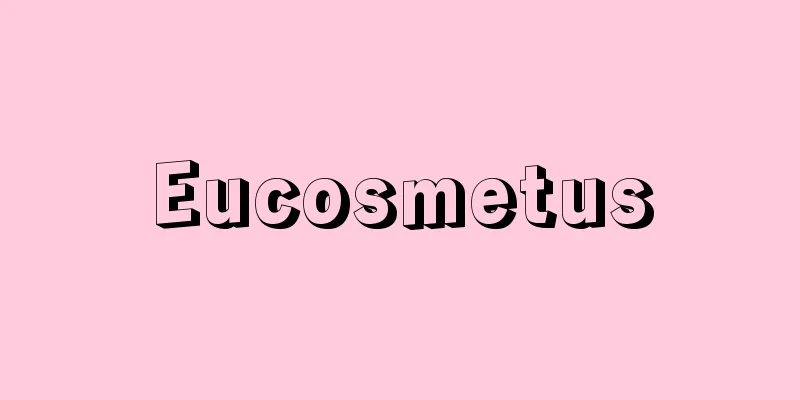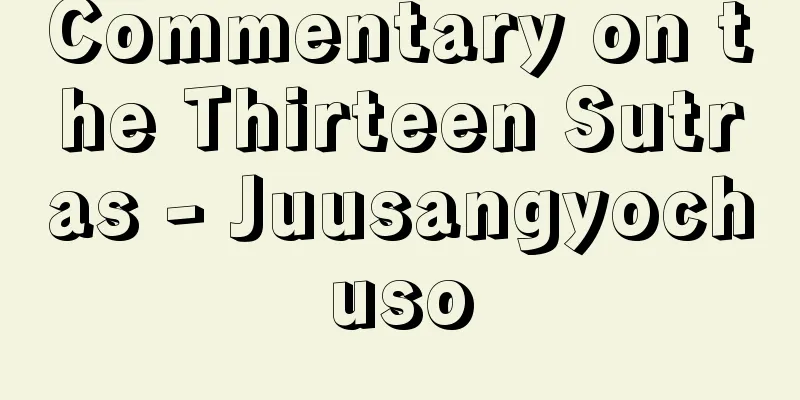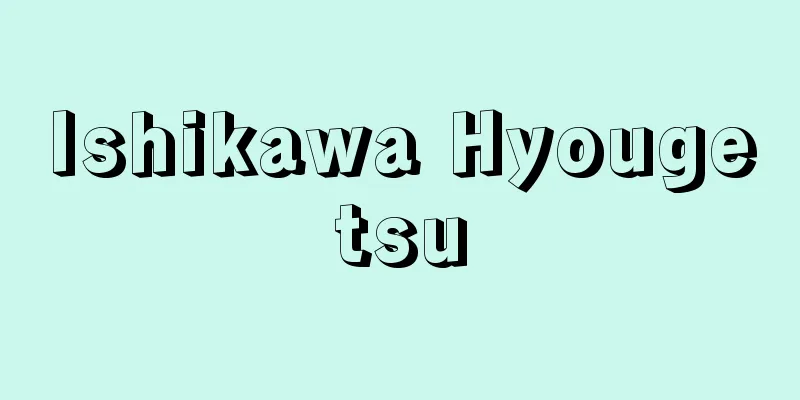Decorative Sutra - Soshokugyo

|
A type of sutra copying that was popular during the Heian period. The purpose of sutra copying is to accurately copy the scriptures, and as a rule, it is written in ink on plain paper (paper that has been as-made and not processed), but those that have been decorated by dyeing the paper, drawing a preliminary design in gold or silver paint, sprinkling gold or silver foil or noge, or by copying with gold or silver paint, are collectively called decorated sutras. Many of the remains date back to the Heian period, but the seeds of this style can be found already in the Nara period, with representative examples being the "Purple Paper Gold Lettering Golden Light Supreme King Sutra" (Nara National Museum, etc.), which was copied in gold letters on purple paper, the "Purple Paper Gold Lettering Avatamsaka Sutra" (Gotoh Museum, Tokyo, etc.), and the "Blue Paper Silver Lettering Avatamsaka Sutra" (Nezu Museum, Tokyo, etc.), which is a sutra with silver letters on blue paper. Other well-known sutras include the "Gejin Mikkyo Volume 4" (Shoren-in Temple, Kyoto), which is made of purple paper and uses light purple colored hemp paper with mica sand sprinkled all over it, and the "Fragment of the Golden Light Sutra on Indigo Paper" (Tokyo National Museum) and the "Fragment of the Golden Light Sutra on Indigo Paper" (private collection), which uses a mix of indigo and purple dyed paper. Even in the Heian period, the "Issaikyo Sutra" (Sutra with gold lettering on dark blue paper) was produced using the decorative techniques of the Nara period, and some of its surviving relics include the "Arakawakyo Sutra" (Kongobu-ji Temple, Wakayama, etc.) for the memorial of Emperor Toba, and the "Chusonji Sutra" (15 volumes of gold and silver written sutras, Daichoju-in Temple, Iwate, etc.) created by Fujiwara Hidehira. On the other hand, gorgeous sutra scrolls imbued with spirituality also began to be created among the Heian aristocrats, one of the reasons for this was the popularity of the "Lotus Sutra" faith among the court aristocrats, which became even more popular as it preached that copying sutras would lead to enlightenment, and that women could also attain enlightenment, leading to a craze for copying sutras. Furthermore, the belief in the Pure Land ideology preached by Genshin (Eshin Sozu) and the idea of the Latter Days of the Law became popular, and people who wished for rebirth in paradise and the prosperity of their families devoted themselves to Buddhist ceremonies and memorial services, and exerted all their individual aesthetic sense and financial means to create extremely ornately decorated sutras. Representative examples of this include the Kuno-ji Sutra (Tesshu-ji Temple, Shizuoka, etc.), which was a reverse memorial service for Emperor Toba in 1141 (Eiji 1), and the Heike Nokyo (Heike Sutra) (Itsukushima Shrine, Hiroshima), which includes a devotional text handwritten by Taira no Kiyomori and includes 32 volumes dating to 1164 (Chokan 2). Other examples include the "Chikubujimakyo" (Hōgon-ji Temple, Shiga Prefecture, and others), which features outline drawings of phoenixes and flowers made with gold and silver paint; the "Togakushigire" (Togakushi Shrine, Nagano Prefecture, and others), which features a single character written inside a pagoda-shaped box; the "One-character Lotus Stand Lotus Sutra" (Ryūkō-ji Temple, Fukushima Prefecture); and the "Kanfugenkyo" (Contemplation Sutra), which was prepared as a booklet of poems and then repurposed as paper for copying sutras. ) scroll (Gotoh Museum of Art, Tokyo), and the Fan-shaped Lotus Sutra scroll (Shitennoji Temple, Osaka, and others), which features gorgeous sketches of genres. Furthermore, noteworthy examples of representative Shosokugyo sutras, written on letters from the deceased, include the Hokyoin Dharani Sutra (Kongo-ji Temple, Osaka) and the Bussetsu Tennyo Sutra (Tokyo National Museum). In the Kamakura period, the "Me-nashi-kyo" is particularly well known, as the sketch paper for a narrative picture scroll was repurposed as the sutra copying paper for the Goshirakawa-in's memorial service. These decorated sutras are important not only in the history of calligraphy, but also in the history of painting, as their decorative sketches and endpapers are rare paintings. [Hiroyuki Shimatani] [Reference] |Source: Shogakukan Encyclopedia Nipponica About Encyclopedia Nipponica Information | Legend |
|
平安時代に盛行した写経の一種。写経は経典を正確に書写するのが目的で、原則として素紙(そし)(漉(す)き上げたままの加工しない紙)に墨書されるが、料紙を染めたり、金銀泥(きんぎんでい)の下絵を描いたり、金銀の箔(はく)や野毛(のげ)をまいたり、金銀泥で書写するような装飾を施したものを、総称して装飾経とよんでいる。遺品の多くは平安時代のものだが、その萌芽(ほうが)はすでに奈良時代にあり、紫紙に金字(こんじ)で書写した『紫紙(しし)金字金光明最勝王経(こんこうみょうさいしょうおうきょう)』(奈良国立博物館ほか)、『紫紙金字華厳経(けごんきょう)』(東京・五島美術館ほか)、また紺紙銀字経として『紺紙銀字華厳経』(東京・根津美術館ほか)などを代表とし、ほかに薄紫の色麻紙に一面に雲母砂子(きらすなご)をまいた料紙を用いる金塵滅(きんじんめつ)紫紙の『解深密経(げじんみっきょう)巻第四』(京都・青蓮院(しょうれんいん))、さらに色紙(しきし)経として『藍紙(らんし)金光明最勝王経断簡』(東京国立博物館)や藍(あい)と紫の染め紙を交用した『金光明最勝王経断簡』(個人蔵)などが知られる。 平安時代に入っても、奈良時代の装飾技法を受けた『紺紙金字一切(いっさい)経』が制作され、鳥羽法皇菩提(とばほうおうぼだい)のための『荒川(あらかわ)経』(和歌山・金剛峯(こんごうぶ)寺ほか)、藤原秀衡発願(ひでひらほつがん)の『中尊寺(ちゅうそんじ)経』(うち15巻金銀交書(こうしょ)経、岩手・大長寿院ほか)などの遺品が伝存している。一方、平安貴族の間に精神性を込めた華麗な経巻も作成されるようになったが、これは宮廷貴族の『法華経(ほけきょう)』信仰の流行がその一因で、写経成仏、女人成仏を説くところからさらに人気が集まり、写経熱が高まった。さらに、源信(げんしん)(恵心僧都(えしんそうず))の説く浄土思想の信仰や末法思想が流行し、極楽往生や一門の繁栄を願う人々は仏事供養に明け暮れし、「尽善尽美(ぜんをつくしびをつくす)」という各自の美意識と財力の限りを尽くして、華麗きわまりない装飾経を生むこととなった。その代表的なものとして1141年(永治1)鳥羽法皇の逆修(ぎゃくしゅ)供養としての『久能寺(くのうじ)経』(静岡・鉄舟寺(てっしゅうじ)ほか)や長寛(ちょうかん)2年(1164)の年紀のある平清盛自筆の願文(がんもん)ほか32巻を完備する『平家納経(へいけのうきょう)』(広島・厳島(いつくしま)神社)がある。また、金銀泥で鳳凰(ほうおう)や草花の下絵を描いた『竹生島経(ちくぶじまきょう)』(滋賀・宝厳寺(ほうごんじ)ほか)、一字を宝塔形の中に書写した『戸隠切(とがくしぎれ)』(長野・戸隠神社ほか)、『一字蓮台(れんだい)法華経』(福島・竜興寺)、歌絵(うたえ)の冊子として用意され、写経の料紙に転用された『観普賢経(かんふげんきょう)冊子』(東京・五島美術館)、華麗な風俗下絵を描いた『扇面法華経冊子』(大阪・四天王寺ほか)など多数があり、さらに亡者の手紙を料紙とした消息経(しょうそくぎょう)の代表遺品として『宝篋印陀羅尼経(ほうきょういんだらにきょう)』(大阪・金剛(こんごう)寺)、『仏説転女(ぶっせつてんにょ)成仏経』(東京国立博物館)なども注目される。 鎌倉時代ではとくに、物語絵巻の下絵料紙が後白河院(ごしらかわいん)追福の写経料紙に転用された『目無し経』が知られる。これらの装飾経は、書道史はもちろん、その装飾下絵や見返しなどが数少ない絵画遺品であることから、絵画史上でも重要な遺品といえよう。 [島谷弘幸] [参照項目] |出典 小学館 日本大百科全書(ニッポニカ)日本大百科全書(ニッポニカ)について 情報 | 凡例 |
>>: Ornament - ornament English
Recommend
Active fault topography
...is a type of landform in which faults are expr...
Rhodoxeralf
…The name Terra Rossa comes from the Italian word...
ESPRIT
European Strategic Program for Research and Develo...
Double refraction
When light is incident on an anisotropic medium, ...
Juglandaceae
...It is also said that if a newlywed couple thro...
Robe - Houe
Abbreviation of Nyoho clothing. Also called Hofu,...
Shin Hasegawa
Novelist and playwright. Born in Yokohama on Marc...
Tottori Plain - Tottori Heiya
The plains are located in the middle and lower re...
Engel, CL - Engel
…The reason given was that it was closer to Russi...
Extension table
A table with a structure that allows the table sur...
Pinianus
…She is famous, along with her grandmother Melani...
Phoenix
Hero of Greek mythology. Son of King Amyntor of Bo...
Heritage Attribution War - Issankizoku Senso
...war in which France invaded the southern Nethe...
Permanent waterproofing agent - waterproofing agent
…These methods are cheap and simple, but the wate...
Loyd, Sam
Born January 30, 1841 in Philadelphia, Pennsylvani...



![Oe [town] - Oe](/upload/images/67cb13d2d0f84.webp)





